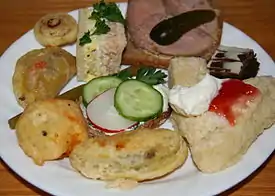Finger food
Finger foods are usually defined as individual portions of food that are small. The ideal finger food usually does not create any mess (i.e. no crumbs, drips, or any kind of mess), but this criterion is often overlooked in order to include foods like tacos.[1] Unfortunately, the complete history of such a broad class of foods is difficult to trace, but one history begins with the French canapés. While the history of finger foods is complex, they are frequently used in the fast food industry and served for social events.


History of finger foods
Finger foods do not share common origin, history, or identity. Therefore, it is difficult to track the full history of finger foods. One such story of origin rests with the French, who had been referring to finger foods as canapés, the French word of sofa, since the late 1700s. These canapés began as slices of toasted or fried bread covered in various toppings. Their name was inspired from how the toppings "sat" on the bread, similar to how humans sit on sofas. Over time, canapés became a word to describe all finger foods served at parties. Eventually, the use of canapé-like concepts were used during the American Prohibition.[2]
Finger foods and prohibition
Following the enactment of American Prohibition laws in 1920, many citizens adapted by drinking in secret. A common place to drink during this time was in speakeasies, often located in the basements of peoples homes. However, while speakeasies made it easier to get a drink, precautions had to be made to ensure guests did not appear intoxicated after leaving to avoid detection. The solution was to serve finger foods, similar to canapés, throughout the night. These finger foods also allowed guests to eat while drinking because of the food's small size. [2]
Parties centered around the consumption of alcohol also noticed a rise in popularity. These cocktail parties also commonly served canapés to guests.[2]
Modern finger foods
There are limitless types of finger foods, each with complicated origins and area of consumption, which makes listing them difficult. However, contemporary finger foods are often used within fast food industries and formal events.[3][4][1]
The fast food industry
The fast food industry is known for its far reaching impact across the globe. One of the big names, McDonald's, inspired the creation of the concept now known as McDonaldization. One of the primary columns of McDonaldization, efficiency, is achieved by the aid of finger foods. The reason for this is the finger food's simplicity: they can be easily assembled through simple recipes and distributed easily.[4] Furthermore, offering finger foods brings several benefits that make them appealing to consumers.[1][4] For example, an interview found that many people will purchase fast food because they get it and eat it quickly. This saves time because parents, for example, do not have to cook dinner and can go home to attend to errands or hobbies.[5] This example of efficiency demonstrates another strength of finger foods: flexibility. People often experience changes in schedules, which makes cooking difficult, but finger foods served by these producers allow time to eat a meal. This means people can pick go to a fast food restaurant, order a breakfast sandwich, and eat it on their way to work. For producers, the simple recipes of finger foods allows them to create new menu options that share ingredients.[4][1]
.jpg.webp)
There are many different finger foods used in the fast food industry. One popular example of an efficient finger food is McDonald's Chicken Nugget. The differences that make the Chicken Nugget a popular finger foods is the removal of bone, skin, gristle, all of which slow consumption. As a result, the Chicken Nugget is easy to eat and consumers do not worry about consuming bones. Another famous example is McDonald's snack wrap, which contains chicken, lettuce, and cheese wrapped in a tortilla. The simple make-up of the wrap allows efficient production for McDonald's and easy consumption for customers.[4]
Formal events, parties, and holidays
The use of finger foods is not limited to the fast food industry. Their attributes have made them a common choice in formal events and celebrations. For example, when serving finger foods, an attending body of people is allowed more mobility and socialization. This is because they do not need to sit down and eat with silverware.[1] Furthermore, the service of finger foods creates a relaxed atmosphere, which helps events feel more casual. Finger foods also can fulfill the needs of many people to keep their hands and fingers entertained, while also satisfying basic cravings, making finger foods an excellent choice.[1][6]
As in the fast food industry, there are many different finger foods. However, many finger foods that are served during holidays or formal events share some characteristics. The first being they become a topic of conversation and interest. Also, as previously mentioned, they satisfy the basic cravings of guests. In Mable Hoffman's finger foods,[1] many of these recipes contain sugar or other ingredients to give a sweet flavor.
References
- Hoffman, Mable; Hoffman, Gar (1989). Mable Hoffman's finger foods. Los Angeles, California: HPBooks.
- Avey, Tori (1 February 2013). "Speakeasies, Sofas, and the History of Finger Foods". PBS.
- Ong, Beng (March 2017). "Thinking Empirically about the McDonaldization Thesis in Penang". Pertanika Journal of Social Sciences & Humanities. 25: 433–443 – via Humanities International Complete.
- Ritzer, George (2013). The McDonaldization of Society. Thousand Oaks, California: SAGE Publications, Inc. ISBN 978-1-4522-2669-9.
- Brembeck, Helene (2006). "Home to McDonald's. The Domestication of McDonald's in Sweden". Advances in Consumer Research - European Conference Proceedings. 7: 256–261 – via Business Source Complete.
- Longman, Kenneth (May 1972). "Eating and Drinking Things". Marketing Science. 2: 36–37 – via Sociological Collection.
Further reading
- The McDonaldization of Society (SAGE Publications, Inc.), George Ritzer ISBN 978-1-4522-2669-9